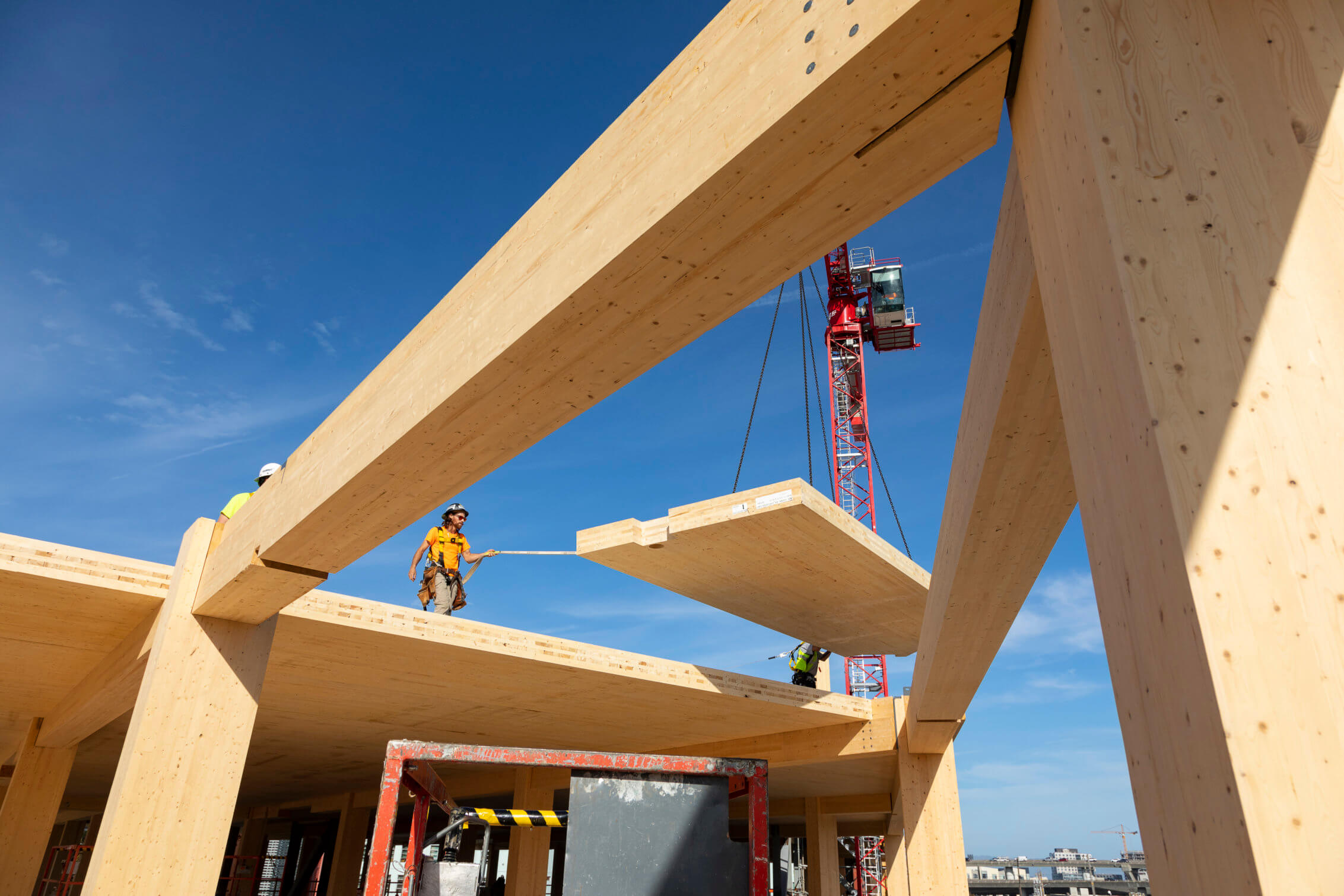09-17-2025

Objectifs d'apprentissage
1. Define key terms that architects should understand as carbon increasingly used as an indicator of building performance
2. Understand the life cycle analyst’s role in creating comparison scenarios.
3. Understand the role of durability in life cycle analysis (using flooring as an example).
4. Understand biogenic carbon, and what inputs will be needed for its accounting.
Comments
Nice presentation
Alexgood study
Robclear description and graphics.
nancyinteresting
PeterGreat Lesson
Ke-ChungGood info
FaisalNice Course
IanGreat info but a lot to digest particularly with the acronyms
Mirkoinformative
KeltieVery importamt topic for Architects who can lead in designing & building a sustainable environment.
Ricardogreat topic. thanks
DAVOUDVery informative presentation.
KimberleyFascinating
JDVery interesting
HoracioInformative
GeorgeGood presentation.
OttoExcellent content
LaylaGreat
StephenVery informative! Thanks!
AmirGreat topics and very informative!
NedaPerfect
AmirDetailed and informative session
Matthewinteresting review
NickGood stuff
Ryaninteresting presentation
fannygood course
BRANKOThanks for information and topics covered.
AlankarThe presentation was very informative and progressive.
Johnvery good in-depth knowledge of wood LCA and carbon
WillExcellent! Definitely would be interested in learning more about the different tools and how they can be used.
LaurieGreat Presentation
Douggreat
LanSustainable
JamesInformative
MartinaGreat! Very informative!
Elenagreat
Gabrielgood information.
BahramGreat course
Saulgreat
Akhileshwas good very interesting topic
MadisonGOOD
SaharHelpful course
LloydGreat topic
MohamedGreat information
Antoniogood course
HaewonGreat info!
AlexandreThank you for the nice presentation.
AbundancioGreat presenter.
ChrisGreat learning experience
Rayvery good course
MATTHEWAmazing Course
ZhongGreat information.
NancieInteresting
JohnGreat
FelipeGood
MandyDetailed and informative
Joelgreat
Thomasawesome course
Ranger Jefforey J.Good information
Seanwell structured course
ZhiliangInformative.
MarcoGood
ZahraInteresting and informative
JeffreyThanks for the providing this seminar at no cost.
Dongmeigood info!
BENGreat info on ZNE
AlexThe content was clear and concise, making it easy to grasp.
Shervininformative presentation
Lok Ching NadiaVery informative. refreshed the knowledge and gained more.
ManzoorGreat learning. impressive presentation. Thanks
Naeem AliThank you for making this presentation available for free.
MariaSo much to learn! Great class.
KarenThis was a difficult subject to completely understand. The presentation did not really include everything that was asked in the questions on the test.
Franklinvery good
DonaldCourse was very interesting.
MichaelGreat presentation.
AlanGood presentation
Marco MiguelGood Lesson.
KendallWell constructed course and quiz.
TomWell-presented and Informative
DomenicoGreat for everyone
Taufiq Ihsanuseful
BojanaStraightforward and interesting
JaredGreat learning how different building materials can be used to lower carbon emissions .
EricGreat presentation and tool exposure. It will be interesting to track the next phase of biogenic carbon measuring.
BennyGreat presentation. Very knowledgeable
Jonathangreat
Karen Juniegood course
Garygood presentation useful for my practice
Roninformitive
Johninteresting subject on carbo
Tae (a.k.a. Francisco)Informative and helpful.
yingthanks for offering course.
nicholasGreat presentation!
ScottWell organized and thorough presentation, thank you. I learned a lot.
YvonneGreat webinar
ChristinaGreat informative easy to digest course!
Ellagood info, subject matter is a bit complicated
RebeccaVery interesting
MariaGreat course
SarkisThis session was a great reminder of how critical it is to account for the entire life cycle of materials when considering embodied carbon. I found it especially helpful to see the role of EPDs and the importance of planning for deconstruction early in the design process. The emphasis on biogenic carbon and future considerations like water integration in carbon calculators was eye-opening—definitely something I’ll carry into my projects.
Monica2365918306Durable Timber: Designing for the Life Cycle of Embodied Carbon
GRATUIT
Architects have always had to adapt to a variety of performance indicators like energy use for their buildings. Recent years have seen a complex shift towards embodied carbon as an indicator. This shift has occurred without a full understanding of the principles of life cycle analysis (LCA), that go into the data sets for carbon. The rise of mass timber has fueled a broad interest in wood and bio-sourced building materials as a potential carbon storage solution. However, there is a real difficulty of capturing complex and regional variations in the simple frameworks of most carbon comparisons. There are competing agendas, methodology, and data presented to specifiers from all sides. Even the best advocates for timber must be humble about the range of variables while defending their choices of regenerative natural building materials. This course starts by helping the modern architectural practice to understand key definitions and principles of carbon calculation metrics and life cycle analysis. It then moves into specific comparisons that highlight the unique attributes of wood, with learning objectives demonstrating the effect of design for durability and biogenic carbon.
Crédits: 1 AIA HSW + 1 GBCI (USGBC/CAGBC) + 1 AIBD Primary + 1 Net Zero (ZNCD) + 1 Sustainable Design + 1 AIBC Core LU + 1 AAA Structured LU + 1 OAA, OAQ, SAA, MAA, AAPEI, NWTAA + 1 Climate Action (OA
Durée: 1h
Vous devez être connectez pour prendre ce cours. Veuillez vous connecter ou créer un compte.
Connection OU Création de comte ShareCommandité par


Durable Timber: Designing for the Life Cycle of Embodied Carbon
GRATUIT
Architects have always had to adapt to a variety of performance indicators like energy use for their buildings. Recent years have seen a complex shift towards embodied carbon as an indicator. This shift has occurred without a full understanding of the principles of life cycle analysis (LCA), that go into the data sets for carbon. The rise of mass timber has fueled a broad interest in wood and bio-sourced building materials as a potential carbon storage solution. However, there is a real difficulty of capturing complex and regional variations in the simple frameworks of most carbon comparisons. There are competing agendas, methodology, and data presented to specifiers from all sides. Even the best advocates for timber must be humble about the range of variables while defending their choices of regenerative natural building materials. This course starts by helping the modern architectural practice to understand key definitions and principles of carbon calculation metrics and life cycle analysis. It then moves into specific comparisons that highlight the unique attributes of wood, with learning objectives demonstrating the effect of design for durability and biogenic carbon.
Crédits: 1 AIA HSW + 1 GBCI (USGBC/CAGBC) + 1 AIBD Primary + 1 Net Zero (ZNCD) + 1 Sustainable Design + 1 AIBC Core LU + 1 AAA Structured LU + 1 OAA, OAQ, SAA, MAA, AAPEI, NWTAA + 1 Climate Action (OA
Durée: 1h
Vous devez être connectez pour prendre ce cours. Veuillez vous connecter ou créer un compte.
Connection OU Création de comteCommandité par

Objectifs d'apprentissage
1. Define key terms that architects should understand as carbon increasingly used as an indicator of building performance
2. Understand the life cycle analyst’s role in creating comparison scenarios.
3. Understand the role of durability in life cycle analysis (using flooring as an example).
4. Understand biogenic carbon, and what inputs will be needed for its accounting.
Comments
Nice presentation
Alexgood study
Robclear description and graphics.
nancyinteresting
PeterGreat Lesson
Ke-ChungGood info
FaisalNice Course
IanGreat info but a lot to digest particularly with the acronyms
Mirkoinformative
KeltieVery importamt topic for Architects who can lead in designing & building a sustainable environment.
Ricardogreat topic. thanks
DAVOUDVery informative presentation.
KimberleyFascinating
JDVery interesting
HoracioInformative
GeorgeGood presentation.
OttoExcellent content
LaylaGreat
StephenVery informative! Thanks!
AmirGreat topics and very informative!
NedaPerfect
AmirDetailed and informative session
Matthewinteresting review
NickGood stuff
Ryaninteresting presentation
fannygood course
BRANKOThanks for information and topics covered.
AlankarThe presentation was very informative and progressive.
Johnvery good in-depth knowledge of wood LCA and carbon
WillExcellent! Definitely would be interested in learning more about the different tools and how they can be used.
LaurieGreat Presentation
Douggreat
LanSustainable
JamesInformative
MartinaGreat! Very informative!
Elenagreat
Gabrielgood information.
BahramGreat course
Saulgreat
Akhileshwas good very interesting topic
MadisonGOOD
SaharHelpful course
LloydGreat topic
MohamedGreat information
Antoniogood course
HaewonGreat info!
AlexandreThank you for the nice presentation.
AbundancioGreat presenter.
ChrisGreat learning experience
Rayvery good course
MATTHEWAmazing Course
ZhongGreat information.
NancieInteresting
JohnGreat
FelipeGood
MandyDetailed and informative
Joelgreat
Thomasawesome course
Ranger Jefforey J.Good information
Seanwell structured course
ZhiliangInformative.
MarcoGood
ZahraInteresting and informative
JeffreyThanks for the providing this seminar at no cost.
Dongmeigood info!
BENGreat info on ZNE
AlexThe content was clear and concise, making it easy to grasp.
Shervininformative presentation
Lok Ching NadiaVery informative. refreshed the knowledge and gained more.
ManzoorGreat learning. impressive presentation. Thanks
Naeem AliThank you for making this presentation available for free.
MariaSo much to learn! Great class.
KarenThis was a difficult subject to completely understand. The presentation did not really include everything that was asked in the questions on the test.
Franklinvery good
DonaldCourse was very interesting.
MichaelGreat presentation.
AlanGood presentation
Marco MiguelGood Lesson.
KendallWell constructed course and quiz.
TomWell-presented and Informative
DomenicoGreat for everyone
Taufiq Ihsanuseful
BojanaStraightforward and interesting
JaredGreat learning how different building materials can be used to lower carbon emissions .
EricGreat presentation and tool exposure. It will be interesting to track the next phase of biogenic carbon measuring.
BennyGreat presentation. Very knowledgeable
Jonathangreat
Karen Juniegood course
Garygood presentation useful for my practice
Roninformitive
Johninteresting subject on carbo
Tae (a.k.a. Francisco)Informative and helpful.
yingthanks for offering course.
nicholasGreat presentation!
ScottWell organized and thorough presentation, thank you. I learned a lot.
YvonneGreat webinar
ChristinaGreat informative easy to digest course!
Ellagood info, subject matter is a bit complicated
RebeccaVery interesting
MariaGreat course
SarkisThis session was a great reminder of how critical it is to account for the entire life cycle of materials when considering embodied carbon. I found it especially helpful to see the role of EPDs and the importance of planning for deconstruction early in the design process. The emphasis on biogenic carbon and future considerations like water integration in carbon calculators was eye-opening—definitely something I’ll carry into my projects.
Monica2365918306
Featured
On-Demand Course
Télécharger notre App


Événements à venir
-

-

-
 Hospitality Building Solutions - Central
Hospitality Building Solutions - Central11-18-2025
-

